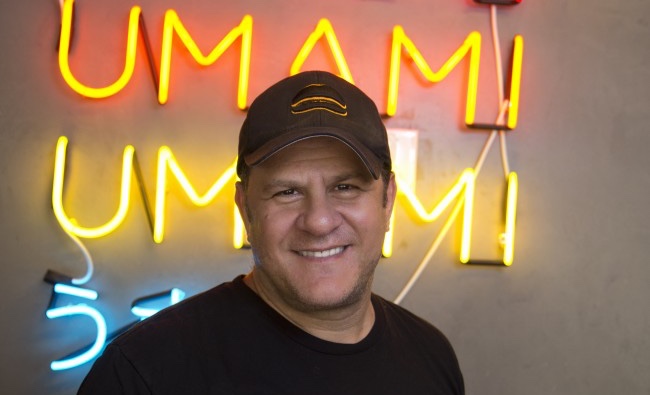
Adam Fleischman, king of the fast-casual food scene and father of Umami Burger, 800 Degrees Pizzeria, and PBJ.LA has just written his first cook book — fittingly titled Flavor Bombs. Fleischman penned this particular book for the home cook looking to expand their knowledge of the science of flavors and taking their recipes to the level of savory heaven that is Umami.
Despite being a guest-judge on Hell’s Kitchen and Iron Chef, and founding three extremely popular fast-casual restaurants in roughly the last decade, Adam found time to put together a book full of some of the most savory dishes you’ll ever serve up. We spoke with Adam over the phone about his new book, the art of seasoning, and the perfect pan. He also gave us some tips perfect for aspiring home-cooks and even shared some recipes from his book perfect to impress your next dinner guests!
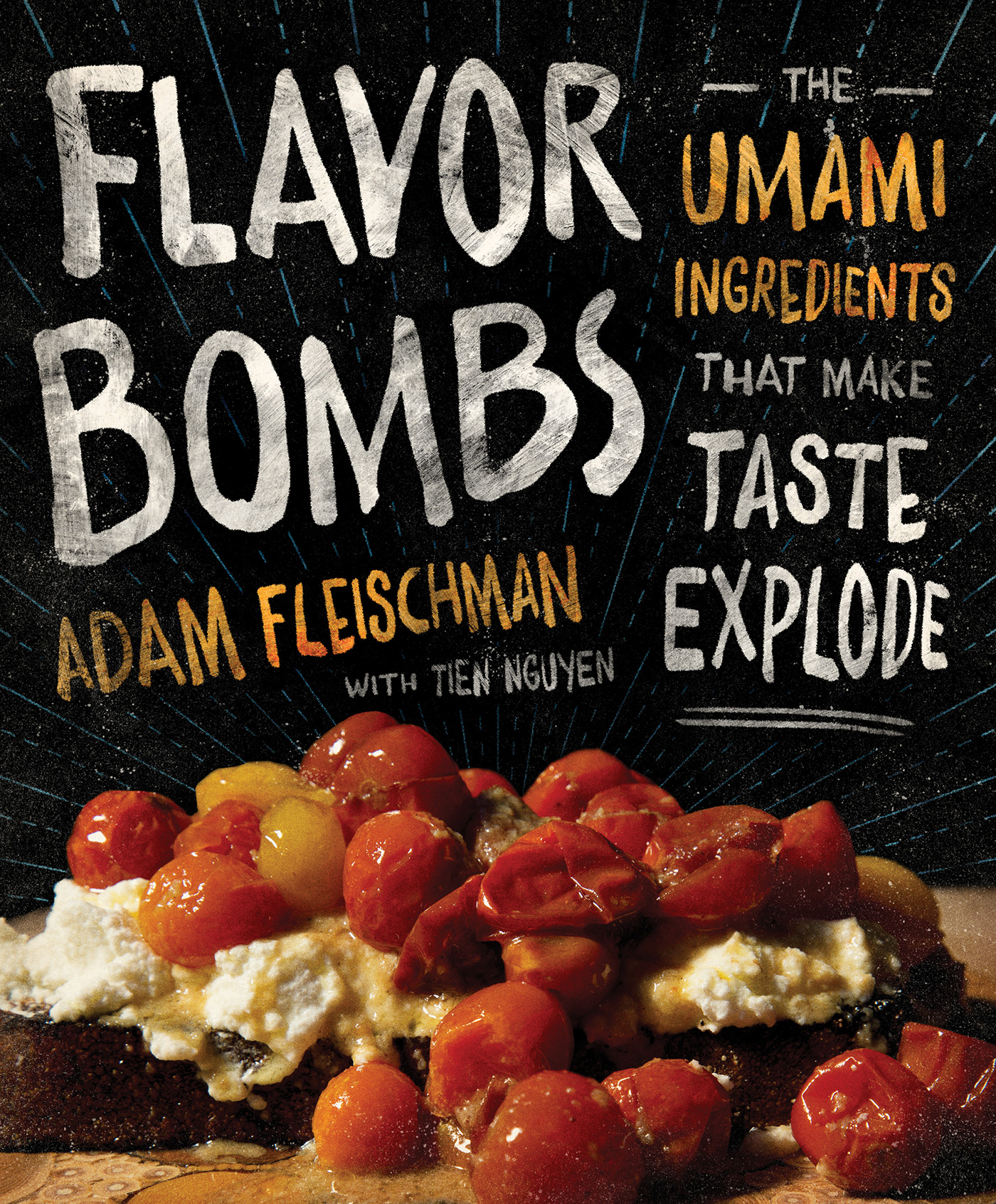
First, I want to say that I really like your book. It’s funny and engaging, and I thought the photography was really great!
Oh, thank you! I’ll pass that along to Wendy, our photographer.
How would you describe umami to someone?
We have five basic tastes that our tongues can detect. Sweet, sour, salty, bitter, and then umami was discovered last in the 20th century. Basically, what that taste is, is a savory taste that’s comprised of glutamates or amino acids. It’s an actual thing, it’s not theoretical. If you have glutamates in your food, you have umami… If you have umami, you have that savoriness, that taste that people really enjoy in burgers, pizza, steak, and Japanese food. All these different cuisines that are based on it.
How exactly is that umami flavor profile made in the kitchen?
You either get it through the ingredients, or through something you add. The book deals with ingredients like tomatoes and mushrooms that are high umami already, but it also deals with added umami enhancers like miso, soy, marmite, and all this other fish sauce. There’s like 20 of them.
In your book, you mention how you had to make mistakes in order to get to the point where you could write it… How important are those mistakes to the creative process?
I think they’re essential because when you make a mistake, you’ve actually attempted it. Whereas, if you are afraid to do something, then you’re never going to get better as a cook. It’s really through the mistakes that you improve in the kitchen, and that’s built up over many, many years. You get to the point eventually when you can tell how something’s going to taste just mentally and that’s where I am. I can tell in my head if something’s going to be good just by adding up all the ingredients in my head.
This is your first book… What made you wait so long? Did you just have to make that many mistakes to get to that point where you thought it was the right time?
No, I do a lot of psychics books, so I wasn’t really interested in doing a cookbook, but then they approached me to do it. They wanted me to do a cookbook, so I just said, “Yes.”
What word of advice do you have for those who let excuses like, not having the right ingredient, get in the way of starting to cook?
I think whether you have the right ingredients, or even the right tools or equipment, the energy and enthusiasm can really overcome a lot of those boundaries. Because, when you look at a lot of these professional kitchens in Italy, they’re very simple. It’s really just a work table with some old woman rolling out pasta. You really don’t need gadgets to cook at the end of the day. You need good fire and you need a pan, and that’s really all you need. The rest is stuff you have to learn, so you might as well focus on the simplicity of it, and just try and make the flavors come out that way.
How important would you say something like courage is? Because, I recently tried to make pad see ew for myself, and I needed a sweet soy sauce and didn’t have any. I tried to make a substitute for it, and I felt like I could taste my lack of confidence in the sauce. If that makes any sense?
Yeah, I totally believe in that! Your attitude and the amount of courage is recognizable in a dish. I do a lot of judging on cooking shows. You can tell the courage of the chef in the dish if you really know food, you can tell how much heart is in the dish, or lack of, or happiness or lack of that. The most important ingredient I think is the cook’s mentality. Then you get the ingredients and the techniques which are all learned.
https://www.instagram.com/p/8ZHSkxy_RA/
Who exactly did you write this book for? What kind of cook?
I wrote it more for the home cook who maybe knows how to cook, but is interested more in the science of flavor and getting more flavor into their recipes.
I wanted to ask a little bit about the impossible burger, but more specifically, do you find crafting vegetarian or vegan dishes a fun challenge? Or more of a business necessity?
It’s definitely a business necessity. That’s the way things are going. But, it’s also a fun challenge as well. That mushroom burger that’s in the book, that I recreated for the book, because I’ve done other veggie burgers before. Obviously, the Impossible Burger, but that one is really, really good. I think it’s fun to try them.
Recently, I read this crazy story that more and more restaurants are removing salt shakers from the table
Yes!
In your book, you said people tend to under salt. Where do you stand on this whole salt shaker removal thing? Is it chefs being too proud or do you support this?
I agree with the chefs. I think that the food should be seasoned properly. But, I was referring to-
In the kitchen?
Yeah, in the kitchen, not seasoning enough and if the dish is properly seasoned in the beginning, the middle, and the end, no one’s ever gonna need to reach for a salt shaker. That said, there are certain foods that require salt. If you’re serving french fries, I think it’s important to have salt around. But, we generally don’t put it on the table … and I’ve never had anyone ever ask me for salt in my house in 20 years…Seasoning is a real art, and it’s the fundamental key to being a good cook, but I think when you cook for a long time, you can learn how to season properly. It also teaches you to taste your food. If you make a big pot of chile, taste it, and see if it’s salted right before you serve it.
If a person wanted to start cooking who was maybe on the fence about it, what kind of tips do you have for that person…What’s an essential pan to have?
I think an essential pan is the cast iron skillet because you could get that Maillard, that caramelization that really works well with umami flavors. I think you want a cast iron skillet, and you can sear something, and you can glaze it, and then you can make vegetables in the same pan. It’s really about keeping the flavors in the dish, and not running out of them.
Any advice for those insecure by some of the beautiful presentation of your recipes in particular?
I tried to make them really messy! It’s more about flavor than beauty. At the end of the day, if something’s really delicious, that’s really the most important function.
Are there any classic staples you think are ready for a reinvention?
God, all of them now are coming back. The crab imperial thing that’s in the book, that’s an old dish from the Eastern shore. Those types of casserole dishes and old school French food, those things are really coming back now because people are going beyond the basics and they’re trying to explore historical versions of things. Historical comfort foods and stuff. I would say comfort foods of the past are definitely all coming back.
One of our other writers, Zach, really wanted me to ask you this since you’re a burger expert. What is really the best cheese for a burger?
It depends, we re-texturize cheese at Umami, so we transform the texture with sodium citrate which is what’s in the book. You could use any one, you’re just changing it into American cheese texture.
Oh, so you get that melt.
Yeah. Yeah, we re-texturize it so it melts. Because American cheese is great because it melts well, but it’s not the most flavorful cheese. If you take, let’s say blue cheese, and you want to re-texturize it so that it melts really well, then that’s a good choice. It’s really whatever’s the most flavorful cheese, and usually those are cheddars, manchegos, like aged cheeses. Cheeses that have really sat and aged, whereas American cheese is not aged… If you’re not up for retexturizing, then I think American cheese is a good way to go because it’s always going to melt properly. I would say a thicker American cheese…would be a good shot.
So, you brought us Umami Burger, 800 Degrees, PBJ.LA, what’s next?
Next, I’m doing four new brands. I’m doing an Italian gyro shop, sort of like the reinvention of the gyro. And I’m doing a coffee place called Cold Cocked, which is about to open, which is sort of a reinvention of the coffee bar…I want to do some more vegetarian concepts like PBJ, that are all plant-based, those types of things.
Are you sticking with that fast-casual format?
Yeah, I like the fast-casual format…It’s accessible and crave-able. We look for crave-able, burgers, and pizza, and Italian gyro’s are all very crave-able!
RECIPES FROM ADAM FLEISCHMAN:
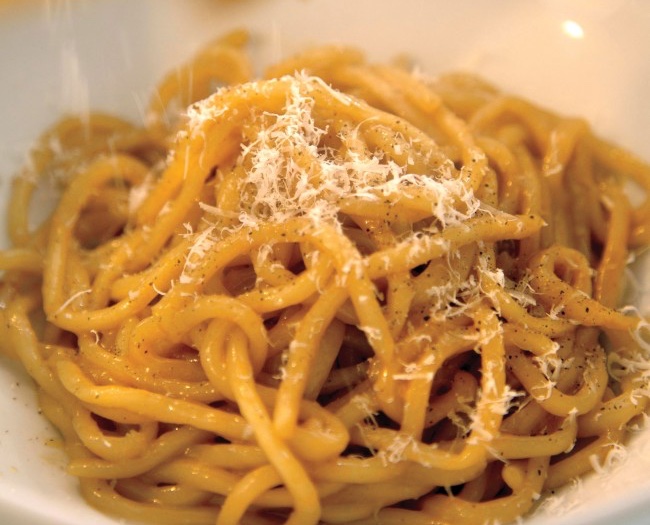
The name says it all. Whip up these garlicky noodles with the leftovers in your fridge for a fast, delicious late-night snack. Everything about this dish is a lesson in improvising with what you have. The Garlic Confit pairs nicely with the Burnt Miso, but fresh garlic will also work, as will roasted garlic. You can omit the miso from the puree if you’re out; even with just garlic and noodles, this is a satisfying quick meal.
One thing you will want to do is keep any leftover sauce. It’ll last up to a week in the fridge and will taste good on most everything. It’s even good right off of the spoon—it’s my peanut butter.
Ingredients:
Sea salt if using Italian pasta
12 ounces whatever noodles you have in your pantry (I like the fresh ramen from the Asian market or a good dried Italian pasta.)
2 tablespoons Burnt Miso (page 47)
½ teaspoon shio koji
10 to 15 cloves Garlic Confit (page 38), depending on how garlicky you like your noodles
2 tablespoons oil from Garlic Confit (page 38) or olive oil
1 tablespoon unsalted butter
Freshly ground black pepper
Fleur de sel (optional)
Parmigiano-Reggiano (optional)
- Bring a large saucepan of water to a boil—don’t forget to salt the water if you’re using Italian pasta—and cook the noodles according to the directions on the package.
- While the noodles boil, make the garlic-miso sauce. Place the Burnt Miso, shio koji, Garlic Confit, and 1 tablespoon of oil in a blender or food processor and puree until smooth. Add the butter and scoop out and add ¼ cup pasta water and puree again. It’ll thin out and become more sauce-like, which is exactly what you want.
- Place a large skillet over low heat and add the remaining tablespoon of oil and the garlic-miso sauce. When the noodles are just about done, drain them or use tongs to transfer them from the saucepan directly into the skillet. Stir to combine, and finish with the pepper.
- Taste for seasoning. If the noodles need a kick of salt, add a pinch of fleur de sel and top with freshly grated Parmesan.
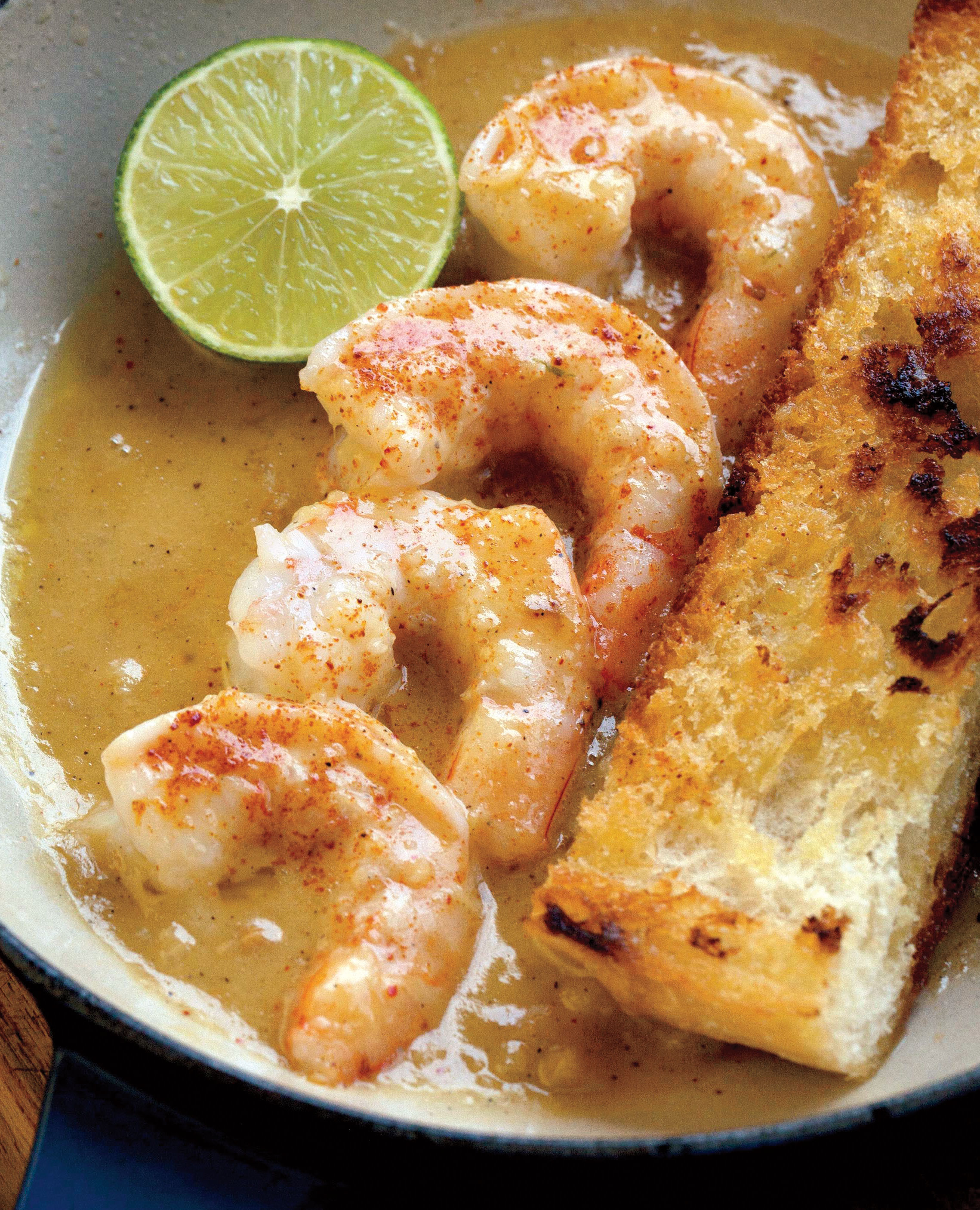
Mojo de ajo is an awesome all-purpose garlic sauce that’s a staple in Latin American cooking. Everyone has their own version of mojo de ajo that involves varying amounts of garlic, lime juice, oil, and salt; in mine I roast the garlic first to really deepen its flavor. From there I toss it with prawns. I prefer to use spot prawns because they are bigger and meatier and won’t overcook as easily as shrimp. If you can’t find spot prawns, ask your fishmonger to pick out large head-on prawns, or sub in high-quality wild-caught shrimp from a responsible source. Store any leftover sauce in the fridge. It is tasty on anything savory.
Ingredients:
2 heads garlic, unpeeled
Extra-virgin olive oil
Splash of dry white wine—use whatever white wine you’re drinking
Splash of white wine vinegar
1 teaspoon fresh lime juice
Sea salt and freshly ground black pepper
1 tablespoon unsalted butter
PRAWNS
1 pound spot prawns or large head-on prawns (see headnote)
2 tablespoons olive oil
2 tablespoons unsalted butter
4 slices rustic bread
- MAKE THE MOJO DE AJO: Preheat the oven to 350°F, with a rack in the top.
- Cut just enough off the top of the garlic heads to expose the cloves, and drizzle a good amount of olive oil directly on top of the cloves, enough to really coat the garlic generously. Wrap both heads, together or separately, in aluminum foil and place on the rack. Bake until the garlic is soft, deeply golden, and your kitchen (if not your whole house) is thick with the aroma of garlic, about an hour. The cloves should be a deep tan, but not black.
- Once the garlic has cooled enough for you to handle, pop the cloves out of their paper skins into a food processor (or mortar), and puree the garlic with the splashes of white wine and white wine vinegar, the lime juice, a splash of extra-virgin olive oil, some salt and pepper, and the butter. It should form a thickened sauce. Set aside to let the flavors meld.
- MAKE THE PRAWNS: Peel the prawns, leaving the head and tail intact (see Flavor Tip). Place the olive oil and butter in a large skillet over medium heat, then sauté the prawns until they’re just opaque, a few minutes. Remove the prawns to a plate, and add the bread slices to the skillet. Toast each side for 2 minutes (you can also grill the bread if you’d prefer).
- To serve, put a slice or two of toast on some plates. Place a few prawns on each slice, then spoon a generous helping of mojo de ajo on top. Leave a bowl of mojo de ajo on the table for anyone who might want more. Dive in.
- FLAVOR TIP: Shrimp and prawn heads have a ton of umami, so give one a try if you’re not otherwise accustomed to eating them. They are delicious
The Umami Burger
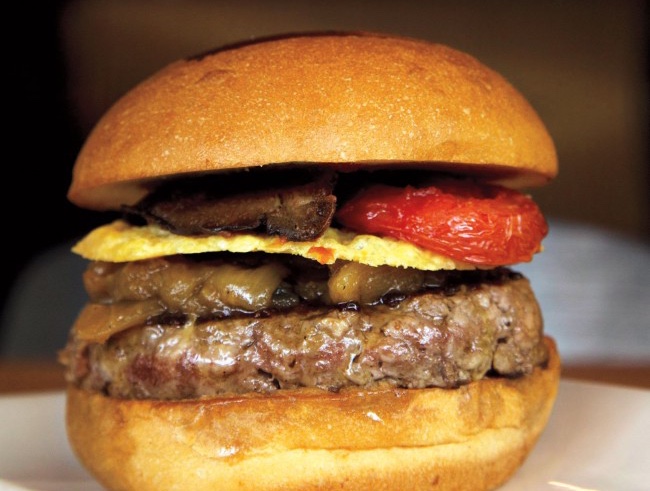
This is it. This is the original. The Umami Burger, the burger that I pulled together in my home kitchen with not much more than a few umami-intense ingredients, a cast-iron skillet, and a food processor. This is versatile: If you don’t have time to make the Oven-Dried Tomatoes, sub in ripe tomatoes. If you’re out of Parmesan cheese, omit the Parmesan cheese crisp. It’s your burger. Do it your way.
Ingredients
1 cup (4 ounces) grated Parmigiano-Reggiano
6 ounces chuck, boneless short ribs, skirt steak, or hanger steak, nicely marbled, about20% fat, or a combination
Sea salt and freshly ground black pepper
1 tablespoon vegetable oil
1 tablespoon unsalted butter
1½ ounces fresh shiitake mushrooms, stemmed
1 potato bun, split
Umami Ketchup
Caramelized Onions
2 slices Oven-Dried Tomatoes (recipe follows) or ripe tomato
- Preheat the oven to 375°F. Line a baking sheet with a Silpat mat or parchment paper.
- Divide the cheese into neat piles on the baking sheet about 4 inches apart. Flatten the piles with a spatula or the bottom of a cup to form 3-inch rounds.
- Bake until the rounds are crisp and golden, about 10 minutes, then remove the pan from the oven and cool in the pan for 10 minutes. Using a spatula, carefully transfer the cheese crisps to a rack and let them cool completely before using; you should have 15 to 20 crisps. You’ll need only one Parmesan crisp per burger; save the rest for other burgers, or for snacking on later. Store them in an airtight container for up to 3 days. Do not refrigerate.
- While the cheese crisps cool, make the patty. Cube the meat and place it in the freezer for 20 minutes (see page 102). When the meat is cold, place it in your food processor and pulse a few times, just until it’s coarsely ground.
- Place a cast-iron skillet on the highest heat. You want the pan to be wicked hot so you can quickly sear the patty crisp without overcooking the inside.
- Dump the meat out on a plate and loosely shape it into a flat ball or something close to that general shape. Don’t pack the patty—it should barely hold together. Season the patty generously with salt and pepper.
- Add the oil to the pan, wait a few seconds, then carefully place the patty in the pan; it should crackle and pop right away.
- Sear the patty for 3 minutes, then flip it over and cook another 3 minutes for a medium-rare burger. Set aside.
- Lower the flame to medium. Place ½ tablespoon of the butter in a small skillet, then toss in the mushrooms. Sauté until the caps are softened, about 2 minutes. Remove the mushrooms, wipe the skillet clean with a paper towel, throw in the remaining ½ tablespoon butter, and toast both halves of the potato bun cut side down.
- When the bun is nice and toasted, remove it from the pan and assemble your burger, starting with the ketchup. I like to ketchup both the top and bottom bun, but use as much or as little as you want. Place the patty on the bottom bun and top with the Caramelized Onions, a Parmesan crisp, mushroom caps, tomato slices, and the top bun. Eat. Enjoy.
Umami Master Sauce
This glutamate-intense sauce can be used for wet applications, like braises and stews and any other dish that cooks low and slow. Since it’s a concentrated sauce with several umami ingredients, a little bit goes a long way. Use a small amount and dilute as necessary.
Ingredients
2 cups top-quality tamari or soy sauce
¼ cup plus 2 tablespoons sherry wine
¼ cup dried wild mushrooms, like porcini
¼ cup red or white miso
¼ cup honey
1 tablespoon Marmite
1 tablespoon shio koji
Hot sauce
1 (4-by-4-inch) piece dried kombu
- Start with the tamari or soy sauce, in a pan over medium heat; do not let boil. Add the sherry wine, dried wild mushrooms, and miso. Stir.
- Add the honey, Marmite, shio koji, some hot sauce, and the dried kombu. Stir for a minute, remove from the heat, and strain. Add water to taste to dilute its intensity, then cool.
- Store, covered, in glass jars for up to around 6 months in your pantry.
Excerpted from FLAVOR BOMBS © 2018 by Adam Fleischman. Photographs © 2018 by Wendy Sue Lamm. Used by permission of Rux Martin Books/Houghton Mifflin Harcourt. All rights reserved.






